Regional Integration in the Inter-City Technology Transfer System of the Yangtze River Delta, China
Abstract
:1. Introduction
2. Theoretical Framework
2.1. Regional Integration: Concepts and Measures
2.2. Integrated Development in the YRD
2.3. Technology Transfer and Regional Development
3. Methods
3.1. Deriving Patent Transfer Data from SIPO
3.2. Network Construction
3.3. Community Detection
3.4. Integration Measured by Weighted Indegree Centrality and Weighted Outdegree Centrality
4. Results
4.1. Overall Integration in Technology Transfer System of the YRD
4.2. Integration in the Technology Supply Chain of the YRD
4.3. Integration in the Technology Sales Chain of the YRD
5. Discussion and Conclusions
6. Note
Author Contributions
Funding
Conflicts of Interest
Appendix A
Study Area
Appendix B
| City | 2001–2005 | 2006–2010 | 2011–2015 | |||
|---|---|---|---|---|---|---|
| Shanghai | 43 | 390 | 430 | 1175 | 2147 | 3599 |
| Hangzhou | 26 | 41 | 282 | 182 | 1051 | 1066 |
| Nanjing | 7 | 14 | 126 | 546 | 947 | 923 |
| Hefei | 0 | 0 | 66 | 82 | 398 | 484 |
| Suzhou | 12 | 54 | 334 | 407 | 2129 | 1914 |
| Wuxi | 4 | 10 | 122 | 159 | 683 | 1192 |
| Changzhou | 5 | 8 | 51 | 67 | 662 | 1178 |
| Zhenjiang | 2 | 4 | 62 | 25 | 296 | 178 |
| Yangzhou | 10 | 3 | 22 | 28 | 270 | 239 |
| Nantong | 0 | 0 | 107 | 56 | 2631 | 4312 |
| Taizhou-J | 5 | 6 | 20 | 215 | 327 | 341 |
| Yancheng | 0 | 0 | 26 | 31 | 458 | 191 |
| Chuzhou | 1 | 1 | 35 | 5 | 166 | 122 |
| Wuhu | 0 | 0 | 31 | 44 | 174 | 479 |
| Tongling | 1 | 0 | 0 | 0 | 33 | 18 |
| Ma’anshan | 0 | 0 | 2 | 13 | 110 | 85 |
| Chizhou | 3 | 0 | 5 | 12 | 83 | 15 |
| Xuancheng | 1 | 0 | 17 | 2 | 128 | 75 |
| Anqing | 0 | 0 | 5 | 3 | 42 | 21 |
| Jiaxing | 6 | 4 | 162 | 48 | 859 | 495 |
| Huzhou | 13 | 2 | 91 | 24 | 532 | 173 |
| Ningbo | 12 | 21 | 153 | 115 | 636 | 814 |
| Zhoushan | 0 | 0 | 0 | 0 | 48 | 8 |
| Shaoxing | 0 | 0 | 75 | 24 | 0 | 304 |
| Jinhua | 14 | 12 | 107 | 55 | 321 | 281 |
| Taizhou-Z | 2 | 6 | 176 | 90 | 576 | 423 |
| City | 2001–2005 | 2006–2010 | 2011–2015 | |||
|---|---|---|---|---|---|---|
| Shanghai | 42 | 296 | 862 | 1015 | 3682 | 3601 |
| Hangzhou | 24 | 14 | 313 | 180 | 1564 | 1333 |
| Nanjing | 21 | 52 | 191 | 196 | 1537 | 1213 |
| Hefei | 6 | 2 | 28 | 57 | 309 | 436 |
| Suzhou | 7 | 26 | 156 | 92 | 1683 | 2239 |
| Wuxi | 8 | 3 | 159 | 100 | 940 | 766 |
| Changzhou | 2 | 12 | 80 | 70 | 621 | 368 |
| Zhenjiang | 3 | 0 | 41 | 2 | 261 | 138 |
| Yangzhou | 1 | 1 | 16 | 25 | 119 | 92 |
| Nantong | 0 | 9 | 93 | 66 | 358 | 365 |
| Taizhou-J | 5 | 5 | 13 | 3 | 151 | 167 |
| Yancheng | 0 | 0 | 8 | 4 | 132 | 120 |
| Chuzhou | 0 | 0 | 8 | 9 | 43 | 106 |
| Wuhu | 0 | 2 | 15 | 1 | 163 | 321 |
| Tongling | 0 | 0 | 6 | 26 | 46 | 22 |
| Ma’anshan | 0 | 0 | 9 | 7 | 60 | 73 |
| Chizhou | 0 | 0 | 0 | 0 | 14 | 31 |
| Xuancheng | 0 | 1 | 18 | 1 | 53 | 89 |
| Anqing | 3 | 9 | 7 | 7 | 50 | 49 |
| Jiaxing | 11 | 1 | 63 | 12 | 329 | 266 |
| Huzhou | 14 | 1 | 32 | 16 | 299 | 231 |
| Ningbo | 8 | 4 | 140 | 85 | 1420 | 1751 |
| Zhoushan | 1 | 0 | 6 | 18 | 55 | 18 |
| Shaoxing | 3 | 2 | 99 | 42 | 707 | 490 |
| Jinhua | 2 | 2 | 29 | 34 | 496 | 575 |
| Taizhou-Z | 6 | 9 | 115 | 18 | 615 | 643 |
References
- Krieger-Boden, C.; Soltwedel, R. Identifying European Economic Integration and Globalization: A Review of Concepts and Measures. Reg. Stud. 2013, 47, 1425–1442. [Google Scholar] [CrossRef]
- Krugman, P.; Venables, A.J. Globalization and the Inequality of Nations. Q. J. Econ. 1995, 110, 857–880. [Google Scholar] [CrossRef]
- Július, H.; Richard, G. Core and periphery in the world economy: An empirical assessment of the integration of the Ddeveloping countries into the world economy. Int. Econ. J. 1999, 13, 35–51. [Google Scholar] [CrossRef]
- Fidrmuc, J. The core and periphery of the world economy. J. Int. Trade Econ. Dev. 2004, 13, 89–106. [Google Scholar] [CrossRef]
- Rodrik, D. Globalisation and Labour, or: If Globalisation is a Bowl of Cherries, Why Are There so Many Glum Faces around the Table? In Market Integration, Regionalism and the Global Economy; Baldwin, R., Cohen, D., Sapir, A., Venables, A., Eds.; Cambridge University Press: Cambridge, UK, 1999; pp. 117–150. [Google Scholar]
- Zhang, X.; Zhang, K.H. How does globalization affect regional inequality within a developing country? Evidence from China. J. Dev. Stud. 2003, 39, 47–67. [Google Scholar] [CrossRef]
- Venables, A.J. Winners and losers from regional integration agreements. Econ. J. 2010, 113, 747–761. [Google Scholar] [CrossRef]
- Kiggundu, M.N.; Deghetto, K. Regional integration: Review of the management literature and implications for theory, policy, and practice. Afr. J. Manag. 2015, 1, 303–332. [Google Scholar] [CrossRef]
- Geyikdagi, N.V. Regional integration in Central Asia. J. Asia-Pac. Bus. 2005, 6, 61–74. [Google Scholar] [CrossRef]
- Thonke, O.; Spliid, A. What to expect from regional integration in Africa. Afr. Secur. Rev. 2012, 21, 42–66. [Google Scholar] [CrossRef]
- Curran, L.; Zignago, S. Regional integration of trade in South America: How far has it progressed and in which sectors? Int. Trade J. 2013, 27, 3–35. [Google Scholar] [CrossRef]
- Jordaan, A.C. Regional integration in Africa versus higher levels of intra-Africa trade. Dev. South. Afr. 2014, 31, 515–534. [Google Scholar] [CrossRef] [Green Version]
- Paluzie, E.; Pons, J.; Tirado, D.A. Regional Integration and Specialization Patterns in Spain. Reg. Stud. 2001, 35, 285–296. [Google Scholar] [CrossRef]
- Berkowitz, D.; Dejong, D.N. Integration: An empirical assessment of Russia. William Davidson Inst. Work. Pap. 2002, 53, 541–559. [Google Scholar] [CrossRef]
- Chung, H. Unequal Regionalism: Regional Planning in China and England. Plan. Pract. Res. 2015, 30, 570–586. [Google Scholar] [CrossRef]
- Ke, S. Domestic Market Integration and Regional Economic Growth—China’s Recent Experience from 1995–2011. World Dev. 2015, 66, 588–597. [Google Scholar] [CrossRef]
- Liu, W.; Dunford, M.; Song, Z.; Chen, M. Urban–rural integration drives regional economic growth in Chongqing, Western China. Area Dev. Policy 2016, 1, 132–154. [Google Scholar] [CrossRef]
- Crane, B.; Albrecht, C.; Duffin, M.K.; Albrecht, C. China’s special economic zones: An analysis of policy to reduce regional disparities. Reg. Stud. Reg. Sci. 2018, 5, 98–107. [Google Scholar] [CrossRef]
- Luo, X.; Shen, J. A study on inter-city cooperation in the Yangtze River Delta region, China. Habitat Int. 2009, 33, 52–62. [Google Scholar] [CrossRef]
- Zhang, G.; Duan, H.; Zhou, J. Investigating determinants of inter-regional technology transfer in China: A network analysis with provincial patent data. Rev. Manag. Sci. 2016, 10, 345–364. [Google Scholar] [CrossRef]
- Li, Y.; Wu, F. Understanding city-regionalism in china: Regional cooperation in the Yangtze River Delta. Reg. Stud. 2018, 52, 313–324. [Google Scholar] [CrossRef]
- Zhang, W.; Derudder, B.; Wang, J.; Shen, W. Regionalization in the Yangtze River Delta, China, from the perspective of inter-city daily mobility. Reg. Stud. 2018, 52, 528–541. [Google Scholar] [CrossRef]
- Anderson, J.E.; Eric, V.W. Trade costs. J. Econ. Lit. 2004, 42, 691–751. [Google Scholar] [CrossRef]
- Combes, P.P.; Lafourcade, M. Transport costs: Measures, determinants and regional policy implications for France. J. Econ. Geogr. 2005, 5, 319–349. [Google Scholar] [CrossRef]
- Markman, G.D.; Gianiodis, P.T.; Phan, P.H.; Balkin, D.B. Innovation speed: Transferring university technology to market. Res. Policy 2005, 34, 1058–1075. [Google Scholar] [CrossRef]
- McCarthy, I.P.; Ruckman, K. Licensing Speed: Its Determinants and Payoffs. Soc. Sci. Electron. Publ. 2017, 46, 52–66. [Google Scholar] [CrossRef]
- Etzkowitz, H.; Leydesdorff, L. The dynamics of innovation: From national systems and “Mode 2” to a Triple Helix of university–industry–government relations. Res. Policy 2000, 29, 109–123. [Google Scholar] [CrossRef]
- Link, A.N.; Siegel, D.S.; Fleet, D.D.V. Public science and public innovation: Assessing the relationship between patenting at U.S. National Laboratories and the Bayh-Dole Act. Res. Policy 2011, 40, 1094–1099. [Google Scholar] [CrossRef] [Green Version]
- Bozeman, B.; Rimes, H.; Youtie, J. The evolving state-of-the-art in technology transfer research: Revisiting the contingent effectiveness model. Res. Policy 2015, 44, 34–49. [Google Scholar] [CrossRef]
- Etzkowitz, H. Innovation lodestar: The entrepreneurial university in a stellar knowledge firmament. Technol. Forecast. Soc. Chang. 2017, 123, 122–129. [Google Scholar] [CrossRef]
- Drivas, K.; Economidou, C. Is geographic nearness important for trading ideas? Evidence from the US. J. Technol. Transf. 2015, 40, 629–662. [Google Scholar] [CrossRef]
- Wang, Y.; Pan, X.; Ning, L.; Li, J.; Chen, J. Technology exchange patterns in China: An analysis of regional data. J. Technol. Transf. 2015, 40, 252–272. [Google Scholar] [CrossRef]
- Marco, A.D.; Scellato, G.; Ughetto, E.; Caviggioli, F. Global markets for technology: Evidence from patent transactions. Res. Policy 2017, 46, 1644–1654. [Google Scholar] [CrossRef]
- Sun, Y.; Grimes, S. The actors and relations in evolving networks: The determinants of inter-regional technology transaction in China. Technol. Forecast. Soc. Chang. 2017, 125, 125–136. [Google Scholar] [CrossRef]
- Feng, Y.; Genna, G.M. Regional integration and domestic institutional homogeneity: A comparative analysis of regional integration in the Americas, pacific Asia and western Europe. Rev. Int. Political Econ. 2003, 10, 278–309. [Google Scholar] [CrossRef]
- Frankel, J.A. Regional Trading Blocs; The Institute for International Economics: Washington, DC, USA, 1997. [Google Scholar]
- Duina, F. Varieties of regional integration: The EU, NAFTA and Mercosur. J. Eur. Integr. 2006, 28, 247–275. [Google Scholar] [CrossRef]
- Jetschke, A.; Murray, P. Diffusing Regional Integration: The EU and Southeast Asia. West Eur. Politics 2012, 35, 174–191. [Google Scholar] [CrossRef]
- Farrell, M. EU policy towards other regions: Policy learning in the external promotion of regional integration. J. Eur. Public Policy 2009, 16, 1165–1184. [Google Scholar] [CrossRef]
- Huh, H.S.; Park, C.Y. Asia-Pacific regional integration index: Construction, interpretation, and comparison. J. Asian Econ. 2018, 54, 22–38. [Google Scholar] [CrossRef] [Green Version]
- Nazarko, J.; Czerewacz-Filipowicz, K.; Kuzmicz, K.A. Comparative analysis of the Eastern European countries as participants of the New Silk Road. J. Bus. Econ. Manag. 2017, 18, 1212–1227. [Google Scholar] [CrossRef]
- Hanson, G.H. Market potential, increasing returns and geographic concentration. J. Int. Econ. 2005, 67, 1–24. [Google Scholar] [CrossRef] [Green Version]
- Brakman, S.; Garretsen, H.; Schramm, M. Putting New Economic Geography to the test: Freeness of trade and agglomeration in the EU regions. Reg. Sci. Urban Econ. 2006, 36, 613–635. [Google Scholar] [CrossRef]
- Bassens, D.; Derudder, B.; Taylor, P.J.; Ni, P.; Hoyler, M.; Huang, J.; Witlox, F. World city network integration in the Eurasian realm. Eurasian Geogr. Econ. 2010, 51, 385–401. [Google Scholar] [CrossRef]
- Brown, E.D.; Derudder, B.; Parnreiter, C.; Pelupessy, W.; Taylor, P.J.; Witlox, F. World city networks and global commodity chains: Towards a world-systems’ integration. Glob. Netw. 2010, 10, 12–34. [Google Scholar] [CrossRef]
- Taylor, P.; Derudder, B.; Hoyler, M.; Ni, P.; Witlox, F. City-Dyad Analyses of China’s Integration into the World City Network. Urban Stud. 2014, 51, 868–882. [Google Scholar] [CrossRef]
- Zhou, J. Economic Globalization, Regional Economic Integration and China’s Economic Development Strategy. In Regional Integration and Economic Development; Saavedra-Rivano, N., Hosono, A., Stallings, B., Eds.; Palgrave Macmillan: London, UK, 2001. [Google Scholar]
- Wei, Y.D.; Fan, C.C. Regional inequality in china: A case study of Jiangsu province. Prof. Geogr. 2000, 52, 455–469. [Google Scholar] [CrossRef]
- Zhao, X.; Tong, S. Unequal economic development in China: Spatial disparities and regional policy reconsideration, 1985–1995. Reg. Stud. 2000, 34, 549–561. [Google Scholar] [CrossRef]
- Wang, Z. The Imbalance in Regional Economic Development in China and Its Reasons. In Private Sector Development and Urbanization in China; Palgrave Macmillan: New York, NY, USA, 2015. [Google Scholar]
- Gottmann, J. Megapolis: The Urbanized Northeastern Seaboard of the United States; MIT Press: Boston, MA, USA, 1961. [Google Scholar]
- Wei, Y. Regional development in China: Transitional institutions, embedded globalization, and hybrid economies. Eurasian Geogr. Econ. 2007, 48, 16–36. [Google Scholar] [CrossRef]
- Van Egeraat, C.; Kogler, D.F. Global and regional dynamics in knowledge flows and innovation networks. Eur. Plan. Stud. 2013, 21, 1317–1322. [Google Scholar] [CrossRef]
- Dicken, P. Geographers and ‘globalization’: (yet) another missed boat? Trans. Inst. Br. Geogr. 2014, 29, 5–26. [Google Scholar] [CrossRef]
- Bathelt, H.; Malmberg, A.; Maskell, P. Clusters and knowledge: Local buzz, global pipelines and the process of knowledge creation. Prog. Hum. Geogr. 2004, 28, 31–56. [Google Scholar] [CrossRef]
- Boix, R.; Trullen, J. Knowledge, networks of cities and growth in regional urban systems. Pap. Reg. Sci. 2007, 86, 551–574. [Google Scholar] [CrossRef] [Green Version]
- Chen, H.; Xie, F. How technological proximity affect collaborative innovation? An empirical study of China’s Beijing–Tianjin–Hebei region. J. Manag. Anal. 2018, 5, 287–308. [Google Scholar] [CrossRef]
- Latapy, M.; Magnien, C.; Vecchio, N.D. Basic notions for the analysis of large two-mode networks. Soc. Netw. 2008, 30, 31–48. [Google Scholar] [CrossRef]
- Newman, M.E.J. Modularity and community structure in networks. Proc. Natl. Acad. Sci. USA 2006, 103, 8577–8582. [Google Scholar] [CrossRef] [Green Version]
- Liu, X.; Derudder, B.; Wu, K. Measuring polycentric urban development in china: An intercity transportation network perspective. Reg. Stud. 2015, 50, 1302–1315. [Google Scholar] [CrossRef]
- Cooke, P.; Morgan, K. The regional innovation system in Baden–Wurttemberg. Int. J. Technol. Manag. 1994, 9, 394–429. [Google Scholar] [CrossRef]
- Asheim, B.T.; Coenen, L. Knowledge bases and regional innovation systems: Comparing Nordic clusters. Res. Policy 2005, 34, 1173–1190. [Google Scholar] [CrossRef]
- Chaminade, C.; Plechero, M. Do regions make a difference? Regional innovation systems and global innovation networks in the ICT industry. Eur. Plan. Stud. 2015, 23, 215–237. [Google Scholar] [CrossRef]
- Chen, L.C. Building extra-regional networks for regional innovation systems: Taiwan’s machine tool industry in China. Technol. Forecast. Soc. Chang. 2015, 100, 107–117. [Google Scholar] [CrossRef]
- Zhang, J.; Wu, F. China’s changing economic governance: Administrative annexation and the reorganization of local governments in the Yangtze River Delta. Reg. Stud. 2006, 40, 3–21. [Google Scholar] [CrossRef]
- Urban, F. China’s rise: Challenging the North-South technology transfer paradigm for climate change mitigation and low carbon energy. Energy Policy 2018, 113, 320–330. [Google Scholar] [CrossRef]
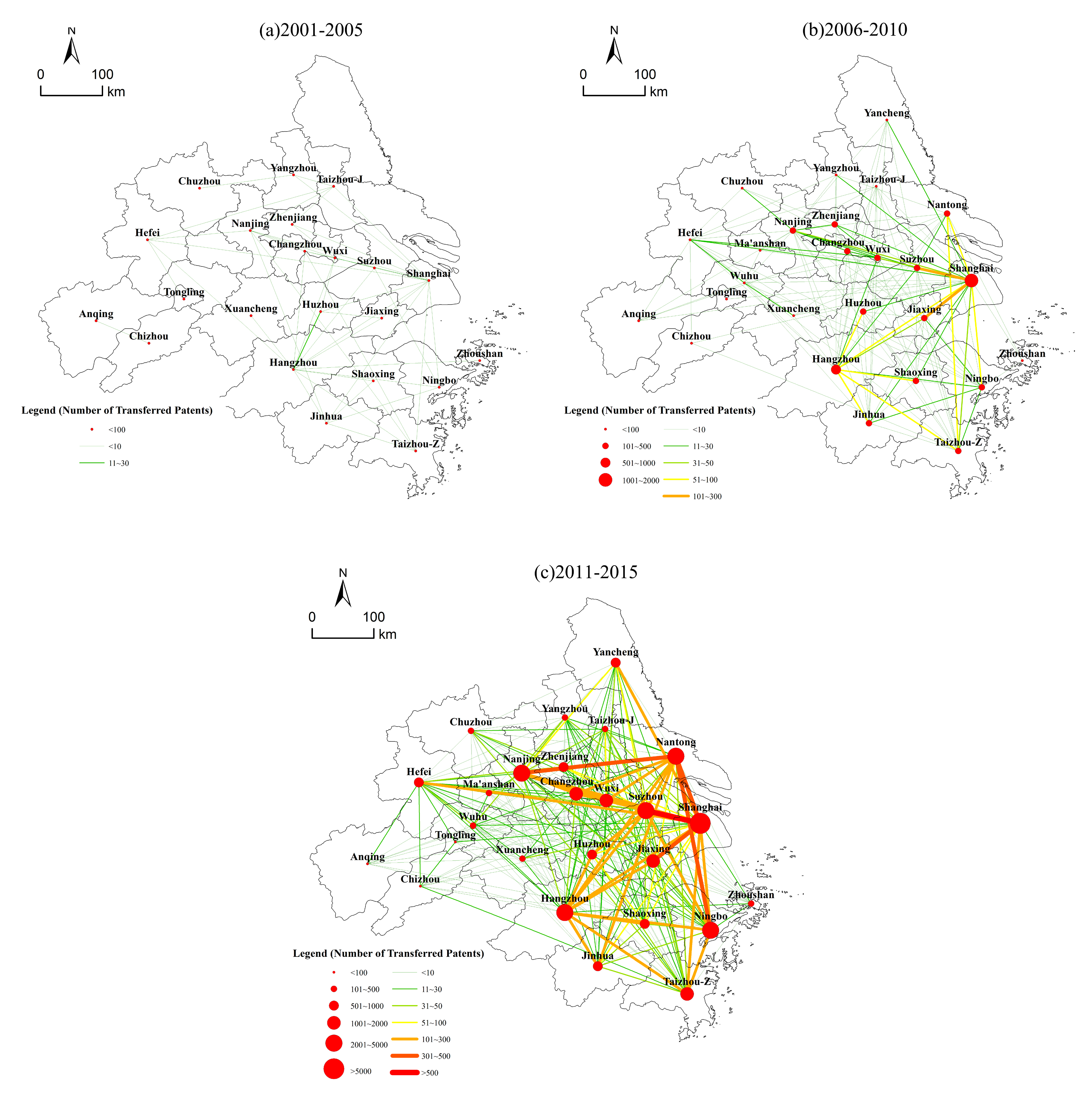
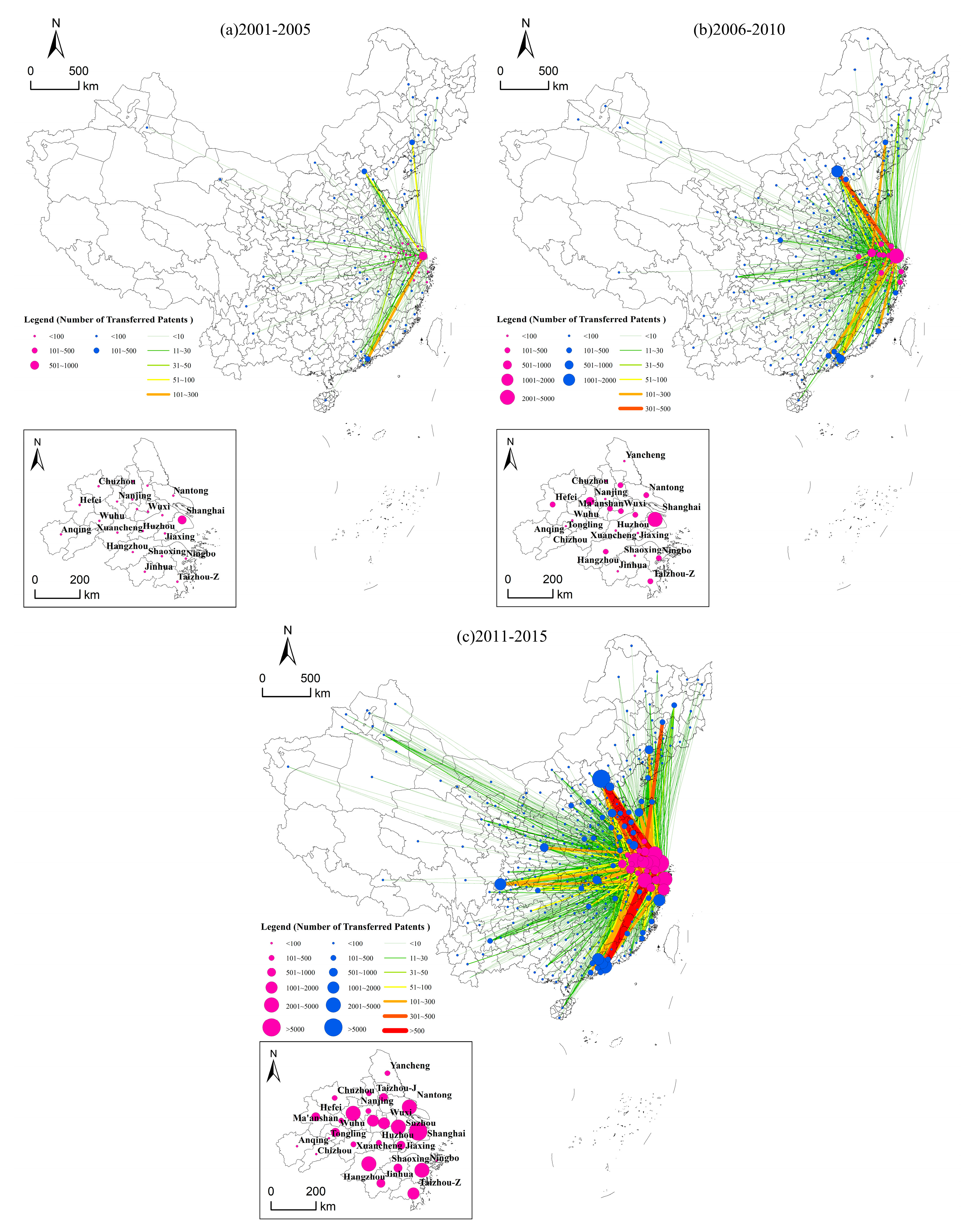
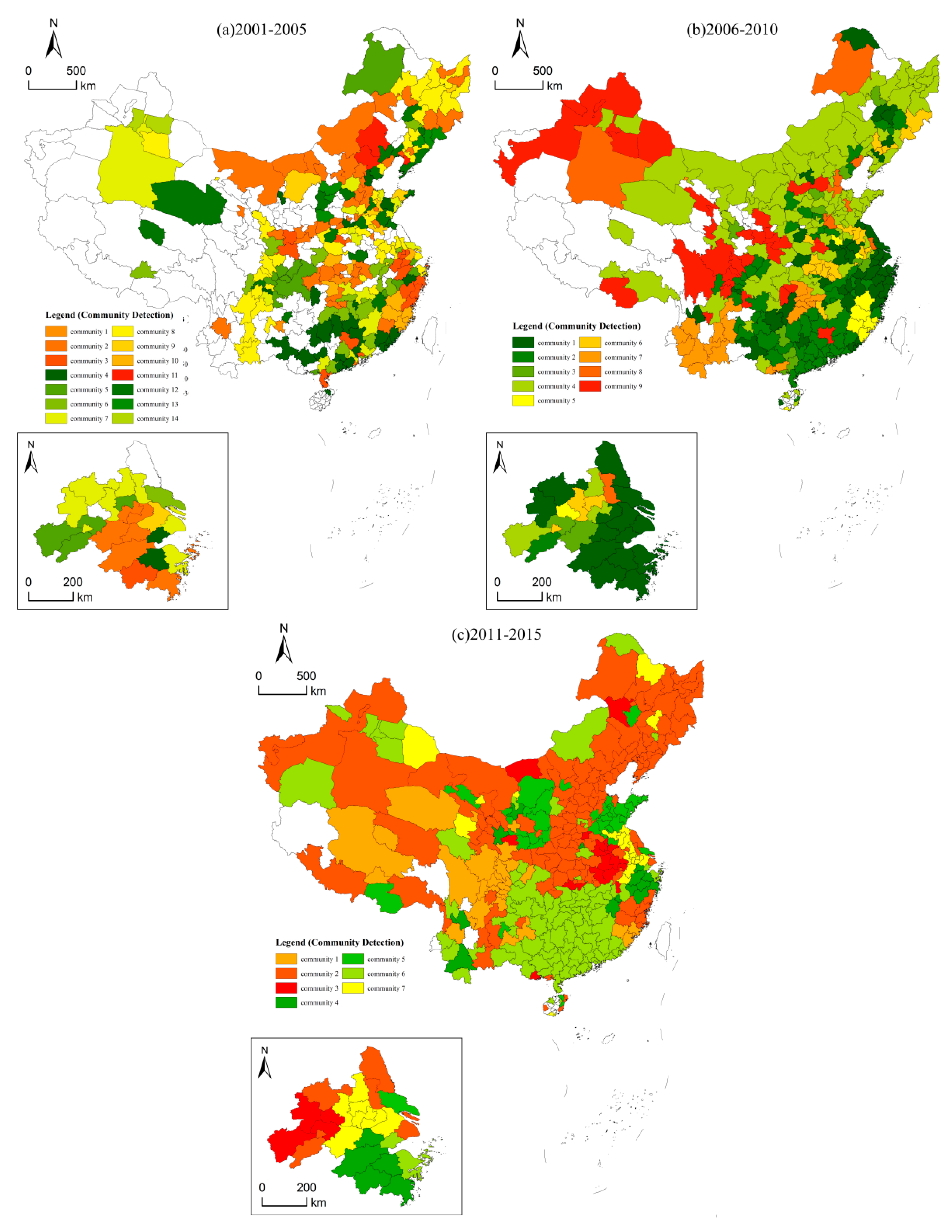
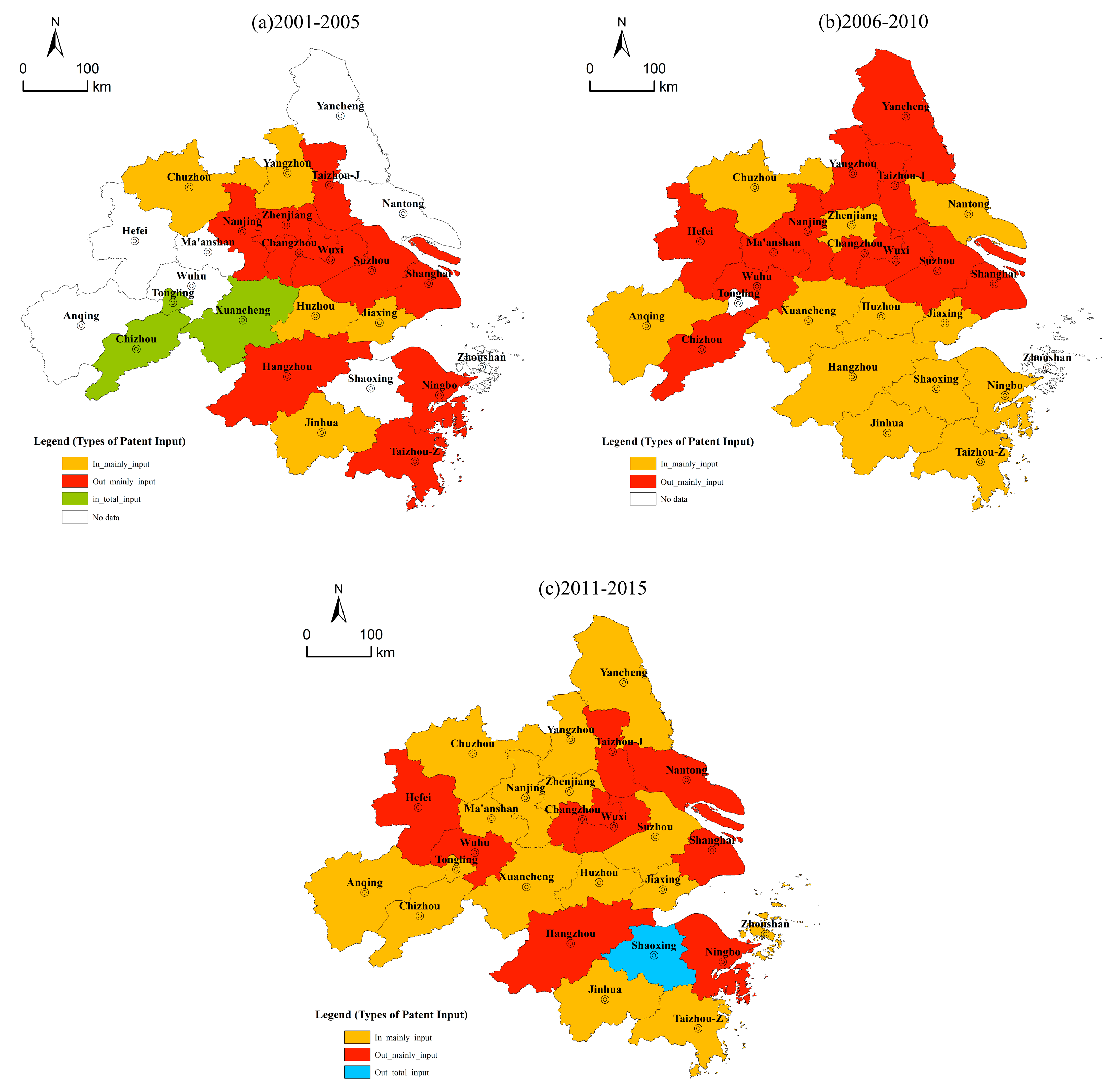
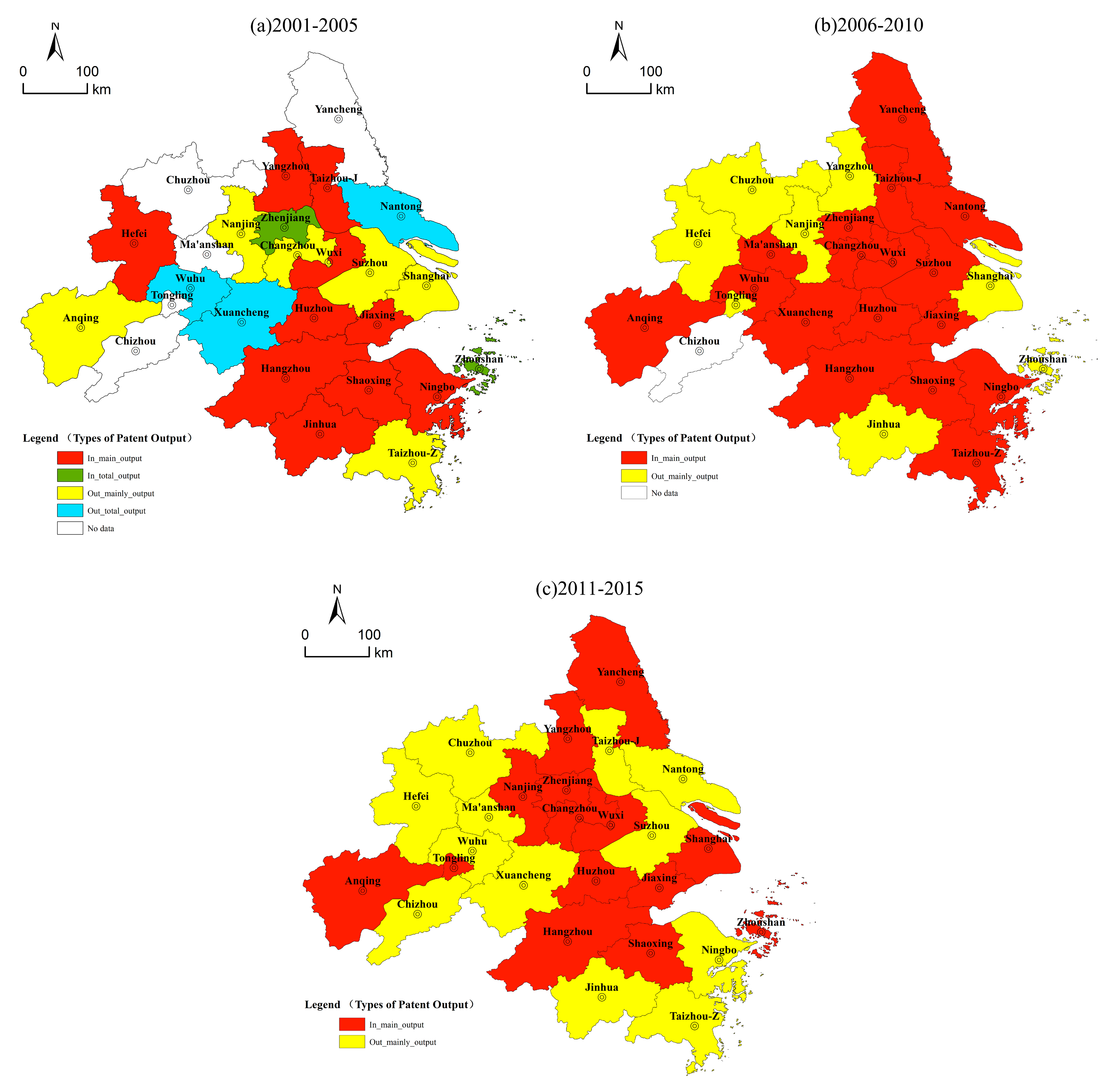
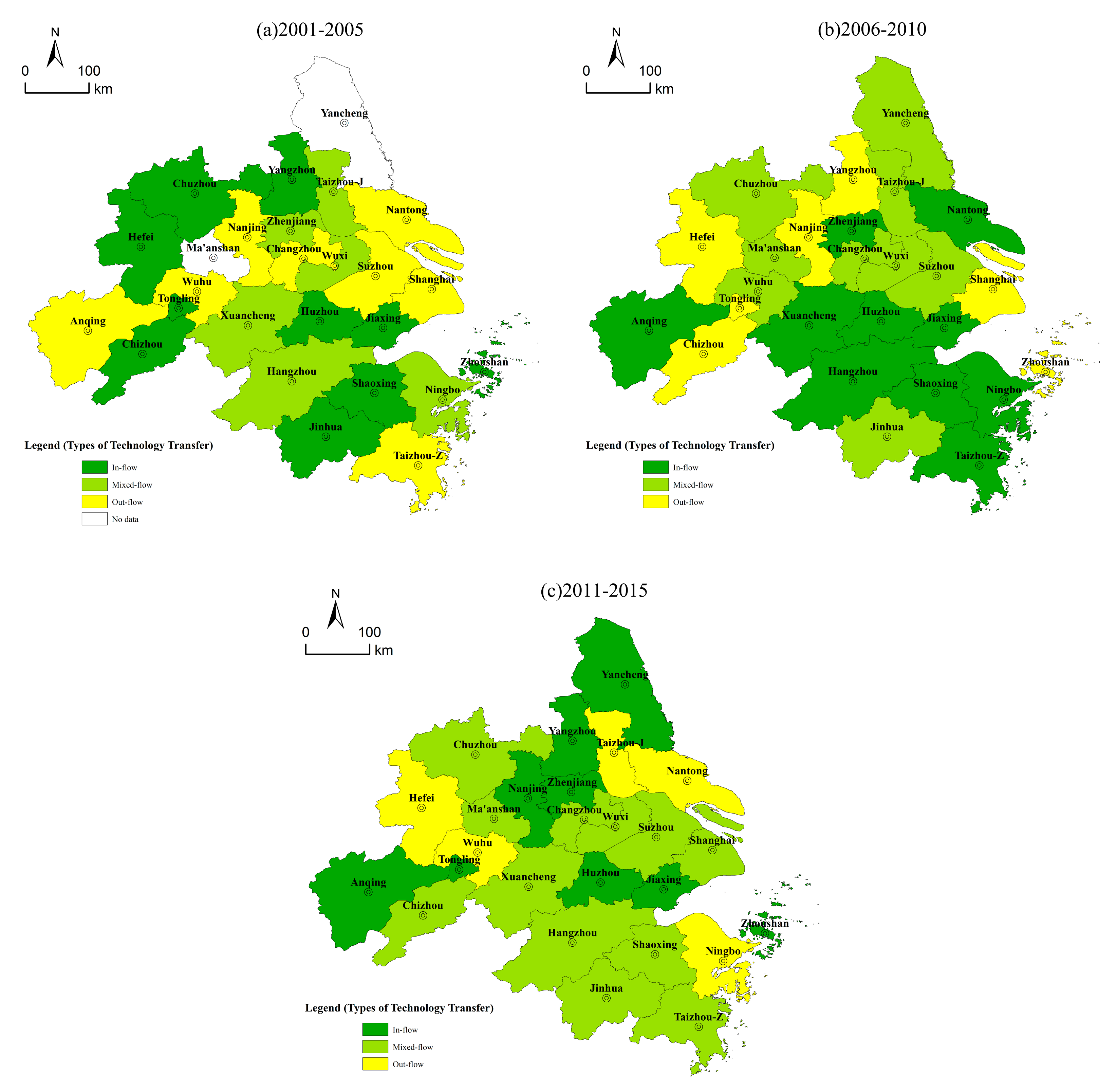
| Types of Technology Transfer | Types of Technology Inputs | Types of Technology Outputs |
|---|---|---|
| In-flow | In_total_input | In_total_input |
| In_total_input/In_mainly_input | / | |
| In_total_output/In_mainly_output | / | |
| In_mainly_input | In_mainly_output | |
| Mixed-flow | In_mainly_input | In_mainly_output |
| In_mainly_output | In_mainly_input | |
| Out-flow | Out_total_input | Out_total_output |
| Out_total_input/Out_mainly_input | / | |
| Out_total_output/Out_mainly_output | / | |
| Out_mainly_input | Out_mainly_output |
| Evaluation Level | Indicators | Description |
|---|---|---|
| Overall | Intra-region transfer share is greater than inter-region transfer share. | |
| Network community detection | The YRD has become an independent community in China’s inter-city patent transfer network. | |
| Technology supply chains | Intra-region input share is greater than inter-region input share. | |
| Technology sales chains | Intra-region output share is greater than inter-region output share. |
| 2001–2005 | 2006–2010 | 2011–2015 | |
|---|---|---|---|
| China’s overall network | |||
| vertices (dl) | 24 | 26 | 26 |
| vertices (en) | 215 | 292 | 321 |
| vertices (dl) + vertices (en) | 239 | 318 | 347 |
| NPT | 3147 | 19,101 | 104,483 |
| Internal network | |||
| vertices (ai) | 22 | 26 | 26 |
| 167 | 2507 | 15,707 | |
| External network | |||
| vertices (bj) | 21 | 26 | 26 |
| vertices (ck) | 68 | 184 | 278 |
| vertices (bj) + vertices (ck) | 89 | 210 | 304 |
| 1027 | 5494 | 34,433 | |
© 2019 by the authors. Licensee MDPI, Basel, Switzerland. This article is an open access article distributed under the terms and conditions of the Creative Commons Attribution (CC BY) license (http://creativecommons.org/licenses/by/4.0/).
Share and Cite
Duan, D.; Zhang, Y.; Chen, Y.; Du, D. Regional Integration in the Inter-City Technology Transfer System of the Yangtze River Delta, China. Sustainability 2019, 11, 2941. https://doi.org/10.3390/su11102941
Duan D, Zhang Y, Chen Y, Du D. Regional Integration in the Inter-City Technology Transfer System of the Yangtze River Delta, China. Sustainability. 2019; 11(10):2941. https://doi.org/10.3390/su11102941
Chicago/Turabian StyleDuan, Dezhong, Yang Zhang, Ying Chen, and Debin Du. 2019. "Regional Integration in the Inter-City Technology Transfer System of the Yangtze River Delta, China" Sustainability 11, no. 10: 2941. https://doi.org/10.3390/su11102941
APA StyleDuan, D., Zhang, Y., Chen, Y., & Du, D. (2019). Regional Integration in the Inter-City Technology Transfer System of the Yangtze River Delta, China. Sustainability, 11(10), 2941. https://doi.org/10.3390/su11102941





